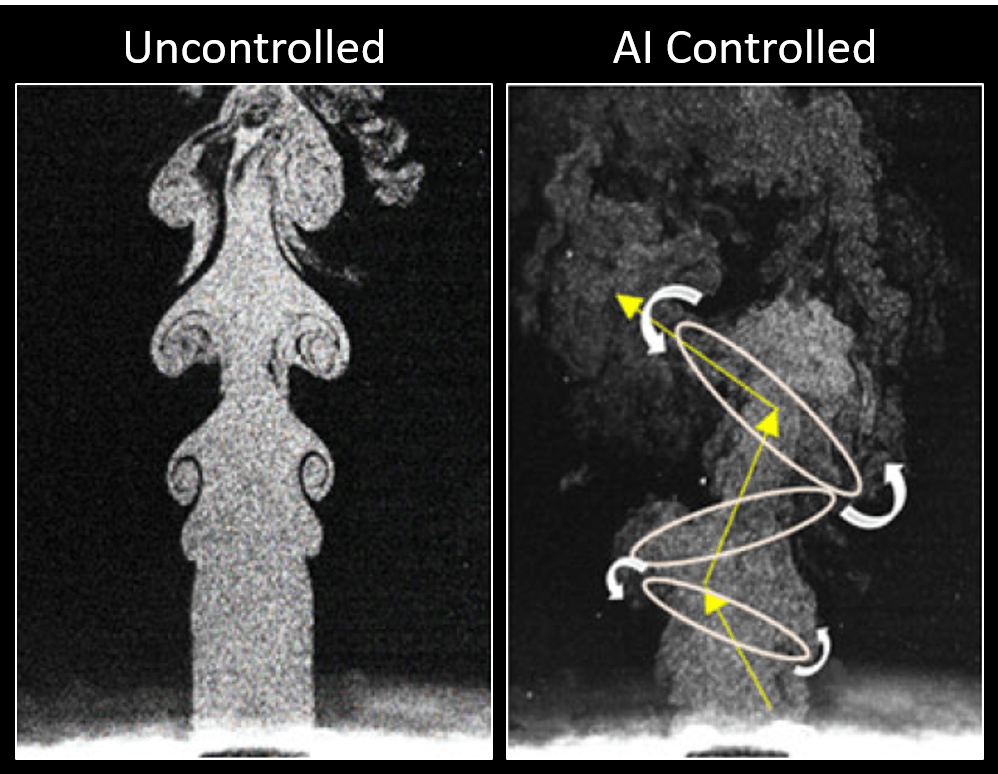Machines Learning Control
This blog entry from Elliott Sutton is one of two winning submissions to the Fluids Writing Competition, from the Journal of Fluid Mechanics and Flow: Applications of Fluid Mechanics. Elliott is studying for a PhD in chemical engineering at the University of Manchester, with a focus on computational fluid dynamics and complex fluids.
With the turn of the 21st century, artificial intelligence has increasingly come to dominate science. For better or for worse, machine learning is here to stay. The field of fluid mechanics has not evaded the use of this powerful tool and for good reason. Using AI regularly offers vast improvements in efficiency over previous technology and allows unimaginable new developments to be realised. Prime example of this is the recent capability of AI to control jets, leading to satellites and spacecraft being able to steer themselves.
The landing of NASA’s Perseverance rover on Mars marked a historic moment in spaceflight. This mission involved a plethora of new gadgets, tested for future flights to Mars and beyond. On board AI was able to map the planet’s surface, decide on the safest place to land and change trajectory, all without human intervention. In previous missions, issues in the last stages of the decent could not be corrected. This is due to signals from Earth taking 5 to 20 minutes to reach the red planet. Such problems would have likely led to catastrophe. Not anymore.
Jets have uses other than in spaceflight, such as mixing chemicals together in industry or for discharging rain and dam water into lakes or rivers. Improved design and control therefore affects a much broader scope of applications.
A new study in the Journal of Fluid Mechanics by an international team of scientists is on the cutting edge of this research. The team set out to improve two particular aspects of jet control: how quickly the jetted fluid mixed with the surroundings and how far the jet travelled. Their AI system was able to rapidly find and improve on previously discovered control methods, before continuing to reveal a superior mode of control. This was accomplishment was made without a need for teaching the computer anything.
Jets are high speed, concentrated flows of turbulent fluid. They can be manipulated either by moving the nozzle or using miniature jets to disrupt the flow. Consequently, their direction, speed, noise level, size or mixing rate can be altered. The team focused on the latter two cases by actively changing the flow patterns that form after fluid leaves the nozzle. This affects how the jet mixes with the environment. Six mini-jets surrounded the end of their nozzle and were fired sequentially, creating fluid structures such as helical swirls or flapping back and forth.
Prior to the advent of AI, finding the optimal firing sequence was a daunting task. This is because there are many parameters that can be altered and each one has to be tested individually. Consequently, extensive and expensive testing was necessary to find the optimal sequence. Now, this can be avoided.

The team used natural selection as their inspiration for improving their AI algorithm; the phenomenon that allows animals to adapt to their environment. Initially, the computer began with 100 individuals with a random firing sequence, which would give a variety of mixing rates. Some better, some worse. In each subsequent generation, only the most efficient individual was permitted to survive. Copies were then made with mutations that led to diversity in the successive generation. After just five generations, the AI not only rediscovered but actually improved the sequences of three already known control patterns, with increased mixing rates. It then went on to find a way of combining these patterns together in a completely unexpected way. The mini-jets were fired in an incredibly complex sequence, improving the mixing efficiency of the jet by 27% over the previous best method. Without AI, it is unlikely this sequence could have been found. The work not only opens up new jet control methods but also establishes a framework that could be replicated into other applications.
Existing AI, according to the researchers, had already matched or outperformed existing control strategies. The new system surpasses even these, with the ability to modulate its 6 mini-jets independently, not formerly possible. Ultimately, novel methods of control will improve the efficiency of jet design, saving energy and money on already operational systems. Meanwhile, it could unlock brand new technology that we have not yet conceived.






